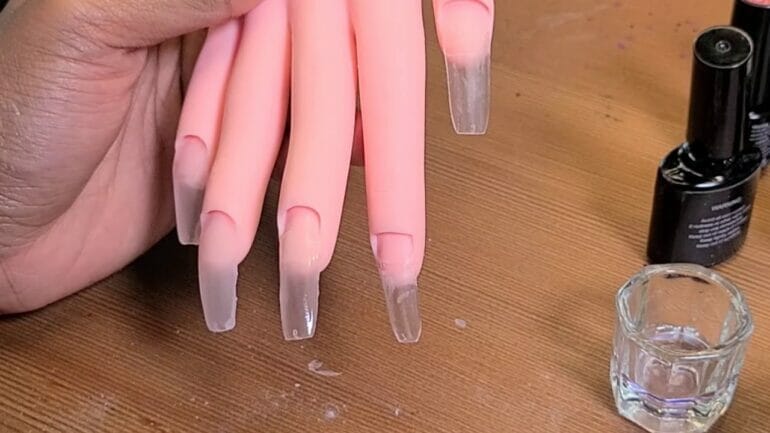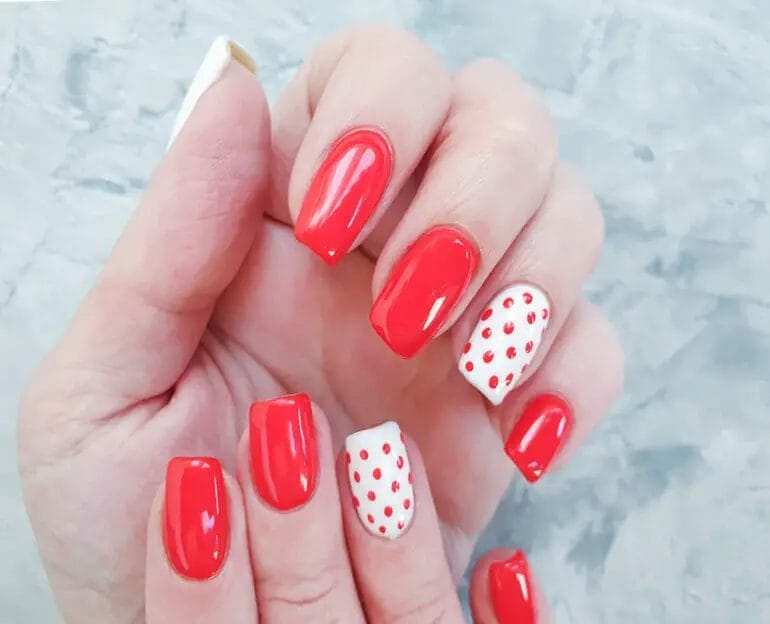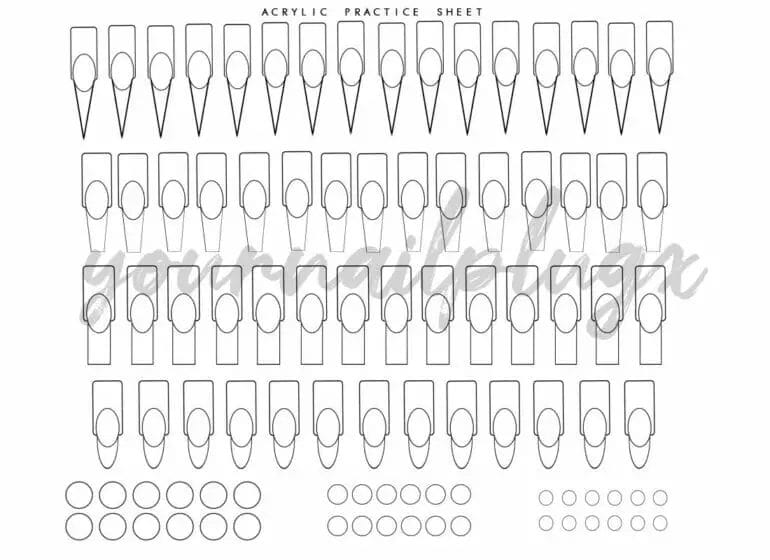Are you eager to practice your acrylic nail skills but don’t have a fake hand? We’ve got you covered! With our guide, you can learn how to practice acrylic nails without a fake hand and still achieve stunning results.
By using everyday items you can find at home, such as a small container, nail polish, and glue, you can create a DIY practice nail surface. This makeshift practice tool allows you to familiarize yourself with the application process, shaping techniques, and nail art designs.
Don’t let the lack of a fake hand hold you back from improving your acrylic nail skills. Let’s dive into our step-by-step guide and discover how you can practice acrylic nails without a fake hand today!

Mannequin Hand Practice
When it comes to practicing acrylic nail application, one of the most effective methods is to utilize a mannequin hand or a DIY hand model. This allows you to practice and perfect your skills without the need for a real hand.
The use of a mannequin hand provides several benefits. First and foremost, it helps you become familiar with the process of acrylic nail application. By repeatedly practicing on the mannequin hand, you can develop muscle memory and refine your technique.

In addition, using a mannequin hand allows you to experiment with different nail shapes. You can try out various styles, such as square, oval, coffin, or stiletto, and see which ones you prefer. This gives you the opportunity to perfect each shape before working on clients.
Furthermore, practicing on a mannequin hand allows you to become comfortable with product application. You can practice applying the acrylic powder and liquid, shaping the nails, and applying polish or designs. This hands-on experience will build your confidence and speed, enabling you to deliver high-quality results.
If you don’t have access to a mannequin hand, you can create your own DIY hand model. You can use materials like foam, clay, or even a plastic glove filled with rice or beans to mimic the shape and feel of a hand. This DIY hand model can be a cost-effective alternative and provide the same benefits as a professional mannequin hand.
Remember, consistency and practice are key to becoming proficient in acrylic nail application. By utilizing a mannequin hand or a DIY hand model, you can maximize your practice sessions and enhance your skills before working on real clients. So get your mannequin hand or create your DIY hand model, and start perfecting your technique!

Practice on False Nails
If you’re a budding nail technician or simply someone who loves experimenting with nail designs, using false nails as a substitute for a hand can be a game-changer. It provides you with the opportunity to practice acrylic nail application without the need for a real hand. Let’s explore the benefits of this method and how it can help you improve your nail art skills.
One of the major advantages of using false nails for practice is the ability to experiment with different shapes, lengths, and designs. With a real hand, you may be limited by the natural nail shape and length, but false nails offer you a blank canvas to work on. You can easily switch between stiletto, square, oval, or any other shape you want to master. This gives you the freedom to practice and perfect various nail shapes without any constraints.
In addition to shapes, false nails allow you to play around with different lengths. If you’re unsure about wearing long nails in your daily life, practicing on false nails gives you the chance to try out longer lengths and see how they feel and look. You can also experiment with shorter lengths to get a better understanding of how different nail lengths can affect the overall design and functionality.
Another benefit of practicing on false nails is the opportunity to explore and refine your nail art skills. From intricate designs to simple patterns, false nails allow you to experiment with various techniques without the pressure of working on a real hand. You can practice freehand painting, stamping, foiling, or any other nail art technique you want to master, all while enjoying the freedom to make mistakes and learn from them.
Using false nails for practice also allows you to save time and resources. Acrylic products can be expensive, and practicing on a real hand means using up more product than necessary. By using false nails, you can focus on perfecting your technique without worrying about wasting valuable resources. This not only helps you save money but also ensures that you have enough product for your actual clients or personal nail needs.
In summary, practicing on false nails provides numerous benefits for aspiring nail technicians and nail art enthusiasts. It allows you to experiment with different shapes, lengths, and designs, giving you the freedom to explore your creativity. Additionally, it helps you refine your nail art skills without putting unnecessary strain on your resources. So, grab a set of false nails and start practicing to take your nail game to the next level!
Practice on Your Non-Dominant Hand
When it comes to applying acrylic nails, one of the most important skills to master is having a steady hand. This is especially crucial when working on clients, as any mistakes can lead to a less-than-perfect result. One way to improve your technique and coordination is by practicing on your non-dominant hand.
Using your non-dominant hand as a practice canvas may seem challenging at first, but it can greatly benefit your nail art skills in the long run. Here are a few reasons why practicing on your non-dominant hand is worth the effort:
Improving Technique
Many nail technicians find it difficult to achieve the same level of precision and control when using their non-dominant hand. By intentionally practicing on this hand, you can focus on smoothing out your technique and correcting any imperfections. Over time, you will find that your non-dominant hand becomes more skilled and capable.
Enhancing Coordination
Working on your non-dominant hand forces your brain and muscles to work together in a different way. This helps in enhancing your overall coordination, which is essential when applying acrylic nails. As you continue to practice, you will notice that your hand-eye coordination improves, allowing you to achieve better results on both hands.
Adapting to Client Needs
As a nail technician, you will encounter clients with different hand dominances. By regularly practicing on your non-dominant hand, you are better prepared to adapt to the specific needs of each client. This flexibility is highly valued in the industry and can contribute to your success as a nail technician.
Building Confidence
Practicing on your non-dominant hand can be a humbling experience, as you may initially struggle with tasks that seem effortless on your dominant hand. However, as you overcome the challenges and gradually improve, it will boost your confidence. This newfound confidence will translate into your work, making you more comfortable and capable when working on clients.
When practicing on your non-dominant hand, it’s important to start with simple tasks and gradually progress to more complex techniques. Here are a few exercises you can try:
1. Basic Shapes:
Begin by drawing basic shapes such as circles, squares, and triangles using your non-dominant hand. This will help you familiarize yourself with the movements required for different nail designs.
2. Painting Nails:
Using your non-dominant hand, practice painting your own nails with different colors. Start with a solid color and gradually progress to more intricate designs, such as ombre or nail art.
3. Applying Acrylic Nails:
Once you feel more comfortable, challenge yourself by applying acrylic nails on your non-dominant hand. Start with simple nail extensions and gradually work your way up to more complex designs.
In summary, practicing on your non-dominant hand is an effective way to improve your technique, enhance coordination, adapt to client needs, and build confidence as a nail technician. Embrace the challenge and dedicate regular practice time to refine your skills. With perseverance and dedication, you will become proficient in applying acrylic nails on both hands.
1. How can I practice acrylic nails without a fake hand?
If you don’t have a fake hand for practicing acrylic nails, you can use alternative methods. One option is to practice on yourself by applying acrylic nails on one hand and then removing them. You can also use a friend or family member as a practice model, allowing you to work on their nails. Another option is to purchase a nail trainer or practice hand to simulate the experience.
2. Can I use regular nail polish for acrylic nails?
No, regular nail polish cannot be used for acrylic nails. Acrylic nails require a specific type of nail enhancement system, which involves applying liquid monomer and polymer powder. Regular nail polish won’t provide the same durability and strength as acrylics.
3. How long do acrylic nails usually last?
Acrylic nails typically last for about 2-3 weeks before requiring a fill or maintenance. However, the lifespan of acrylic nails can vary depending on factors such as your nail growth, how well you care for them, and the skill of the nail technician.
Conclusion:
In conclusion, if you want to practice acrylic nails without a fake hand, there are a few options available. First, you can practice on willing friends or family members who are open to being your “mannequin.” This will give you a real-life experience and allow you to perfect your skills. Another option is to use practice tips or nail art display sticks, which can be attached to your own fingers for a lifelike feel. Additionally, there are online tutorials and virtual simulators that can help you practice the techniques and learn the art of acrylic nails. Remember, practice makes perfect, and with dedication and persistence, you can master the art of acrylic nails without the need for a fake hand.
